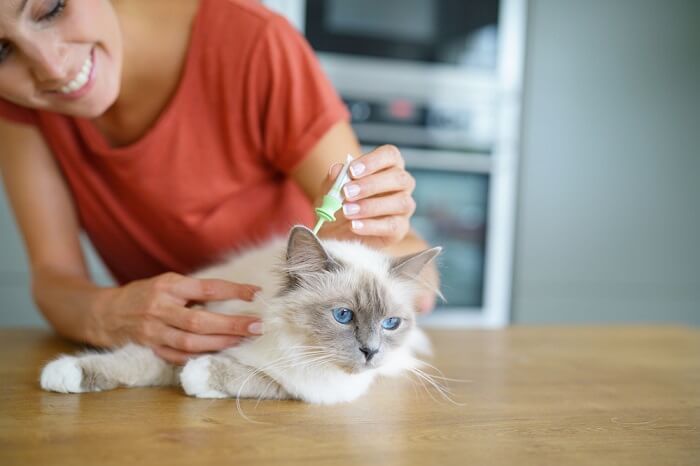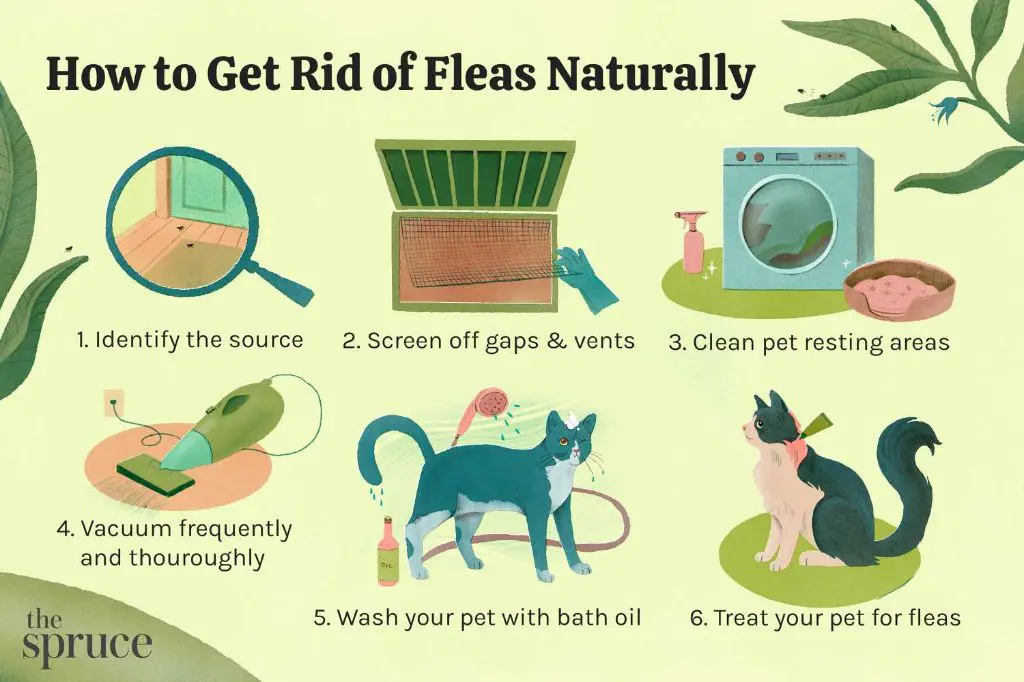Cat fleas (Ctenocephalides felis felis) are the most common types of external parasites found on cats and kittens (Azrizal-Wahid & Rahman, 2019). They are wingless, blood-feeding insects, that have a complete metamorphosis life cycle with egg, larva, pupa, and adult stages. Female fleas can lay up to 50 eggs per day and the eggs take 2-3 days to hatch into larvae. The larvae feed on organic debris and mature into pupae within 1-2 weeks. The pupae can remain dormant for months waiting for optimal conditions to emerge as adults in about a week. Adult fleas only live for 2-3 weeks but in that time can bite cats repeatedly to feed on blood, causing discomfort, itching, inflammation, and blood loss. Heavy infestations in kittens especially can lead to anemia. Fleas can also transmit other parasites and pathogens like tapeworms and cat scratch disease between cats (Abdullah et al., 2019). Controlling flea populations is critical for promoting cat health and wellbeing.
Flea Life Cycle
The cat flea life cycle involves four distinct stages:
Egg
Adult fleas lay eggs, which fall off the host into the environment. Flea eggs are small (about 0.5 mm), white, and smooth. They can survive for months before hatching.
Larva

Flea eggs hatch into larvae in as little as 2 days. The larvae are worm-like, legless, and avoid light. They feed on organic debris and adult flea feces, which contains dried blood. The larval stage can last 1-3 weeks.
Pupa
Larvae spin a silken cocoon to pupate inside. The pupae are sticky and don’t move, making them hard to spot. After 1-2 weeks, adult fleas emerge from the cocoon.
Adult
Adult fleas are wingless insects about 1/16 to 1/8 inches long. Once they emerge, they immediately seek a host for a blood meal. After feeding, the female fleas begin laying eggs, repeating the life cycle.
Flea Reproduction
Fleas can reproduce at an incredibly rapid rate. Female fleas start producing eggs within 24-48 hours of taking their first blood meal and can lay up to 50 eggs per day (https://www.hartz.com/how-fast-do-fleas-reproduce-and-how-can-i-stop-the-cycle). Optimum conditions allow the flea life cycle to be completed in as little as 2-3 weeks, allowing populations to grow exponentially in a short period.
The eggs are laid on the host but fall off into carpets, bedding, furniture and other areas. They are sticky and adhere to these surfaces, remaining in the environment until hatching. Just one female flea can produce hundreds to thousands of eggs over her lifetime (https://yourpetandyou.elanco.com/us/parasites/fleas/flea-life-cycle-and-how-it-affects-your-pet).
With rapid reproduction and egg dispersal, flea populations can quickly infest an entire home. Breaking the flea life cycle is key to getting an infestation under control before it grows out of hand.
Signs of Flea Infestation
There are several common signs that indicate your cat has a flea infestation, including:
- Excessive scratching and itching – Fleas bite and feed on your cat’s blood, causing irritation and itchiness. You may see your cat scratching or biting itself frequently.
- Flea dirt – Small dark specks on your cat’s skin are actually flea feces. You can distinguish it from regular dirt by putting some on a damp paper towel – flea dirt will turn reddish as the blood in it leeches out.
- Hair loss and hot spots – Constant scratching and licking from flea irritation can cause hair loss and raw, inflamed lesions on your cat’s skin called hot spots.
- Fleas visible on cat – Sometimes you may actually spot adult fleas crawling on your cat’s skin, especially if the infestation is severe.
- Anemia – Heavy infestations can lead to anemia from blood loss.
If your cat is displaying any of these signs, it likely has fleas and needs prompt treatment. The earlier fleas are dealt with, the less chance they have to multiply and create an even worse infestation. Check with your vet if you notice any of these flea symptoms.
Treating the Environment
One of the most important steps in getting rid of fleas is to thoroughly clean your home to remove eggs, larvae, and adult fleas. Vacuuming all carpets, rugs, and upholstered furniture is essential (source). You’ll want to use the hose attachment to vacuum crevices and cracks where fleas may be hiding. The vibrations and suction will help dislodge fleas from their eggs and force them into the vacuum bag.
It’s recommended to vacuum every day for at least 3-4 weeks to ensure you capture newly hatched fleas. Be sure to throw away the vacuum bag after each use so any fleas don’t escape back into your home. Steam cleaning carpets, rugs, and upholstery is also effective at killing fleas and eggs due to the high heat (source).

Washing all pet bedding, pillows, curtains, throws, and other washable fabrics in hot, soapy water will help destroy fleas and eggs. Dry on a hot setting as well. Be sure to move furniture to vacuum underneath and don’t forget to vacuum mattresses too (source). Thoroughly treating your home environment is crucial for getting rid of fleas.
Oral Flea Medications
Oral flea medications work by entering the cat’s bloodstream after being ingested and spreading through the body. The active ingredients then accumulate under the skin’s surface and kill adult fleas rapidly after they bite the cat and ingest the treated blood.
Some common oral flea treatments for cats include:
Capstar – Contains nitenpyram as the active ingredient and begins working within 30 minutes to kill adult fleas. It provides fast relief but only lasts for 24 hours, so is best used in conjunction with other medications.
NexGard – Contains afoxolaner and protects against both fleas and ticks for a month at a time. It is available only by prescription.
Comfortis – Contains spinosad and kills fleas before they can lay eggs, providing month-long protection with a single dose.
The oral flea medications take various times to be fully effective, ranging from 30 minutes up to 12 hours. They provide an easy oral administration and have the benefit of killing fleas rapidly while maintaining protection over weeks or months depending on the specific medication.
Topical Flea Treatments
Topical flea treatments are liquid medications applied directly onto the skin, usually at the base of the neck or between the shoulder blades. They are absorbed through the skin and spread through the oils on the cat’s skin and coat to kill adult fleas and prevent eggs and larvae from developing into mature fleas.
Topical treatments like Frontline, Revolution, and Advantage work by interfering with the nervous system of the fleas, causing paralysis and death. Some topical treatments combine ingredients that kill adult fleas as well as eggs and larvae. They are very effective when applied monthly according to the label instructions.
Advantages of topical flea treatments include ease of application, effectiveness for 1-3 months depending on the product, and minimal handling or ingestion by the cat. They are generally safe if used as directed, though mild skin irritation may occasionally occur. It’s important to apply the correct dosage based on the cat’s weight.
Flea Collars

Flea collars work by releasing small doses of insecticide onto your cat’s fur to kill fleas and ticks. The insecticide spreads across your cat’s coat when they move around. There are a few types of flea collars:
Pyrethroid collars contain pyrethroid insecticides like permethrin, deltamethrin, or tetrachlorvinphos. These chemicals attack the nervous system of insects. Pyrethroid collars offer protection for several months. Some popular pyrethroid flea collars include the Seresto collar and Bayer flea collar.
Organophosphate collars contain organophosphate insecticides like chlorpyrifos, propoxur, or diazinon. These disable the enzyme that regulates nerve impulses in insects. Organophosphate collars provide shorter-term protection, usually 1-3 months. Some popular options are the Primova collar and Rolf Club collar.
When shopping for a flea collar, look for one that provides long-lasting, waterproof protection. Make sure it’s an appropriate size and formulation for your cat’s age. Check the product description for any safety precautions. It’s important to monitor your cat’s neck area periodically for signs of skin irritation. Overall, flea collars present a convenient and effective flea treatment option.
Natural Flea Treatments
Some pet owners prefer to use natural treatments to get rid of fleas on cats rather than chemical-based products. There are several natural options that can help repel and kill fleas:
Essential oils like lavender, peppermint, tea tree, and citrus oils can help repel fleas when diluted and applied to the cat’s coat. The strong scent masks the smell of the cat to fleas and makes them avoid the area. It’s important to heavily dilute essential oils before use on cats, as they can be toxic in high concentrations. Only use food-grade quality oils.

Apple cider vinegar and lemon juice contain acids that help alter the pH balance of a cat’s skin when applied topically or given orally. This makes the skin less hospitable for fleas. A 50/50 diluted apple cider vinegar solution can be gently rubbed into the coat or given in small amounts in food.[1]
Herbal dips made from herbs like rosemary, fennel, and rue can be gently rubbed into the cat’s coat and skin to help repel fleas when used regularly. The herbs’ compounds are unappealing and toxic to fleas.
It’s important to monitor cats closely when using natural treatments, as they can still cause skin irritation in some felines. Natural options may need to be reapplied more often than chemical preventatives. Consulting a vet is recommended before trying natural flea solutions.
Preventing Reinfestation
Even after successful treatment, reinfestation is common if preventative measures are not taken. Here are some tips to help prevent fleas from returning:
- Vacuum all floors, furniture, and pet bedding frequently. Make sure to empty the vacuum or dispose of the bag after each use to remove flea eggs and larva. [1]
- Wash all pet bedding weekly in hot, soapy water to kill any flea eggs or larvae. [2]
- Use flea control yard sprays or granules outdoors to treat areas where pets spend time. Focus on shady, moist areas that are ideal flea habitats.
- Bathe and treat any other pets in the household to ensure all animals are protected.
- Continue using flea prevention medication year-round as directed, not just during flea season.
- Avoid over-the-counter foggers or bombs as they can disperse fleas into other areas of the home.
With diligence about prevention, vacuuming, and continuing flea medication, reinfestation can be avoided.
